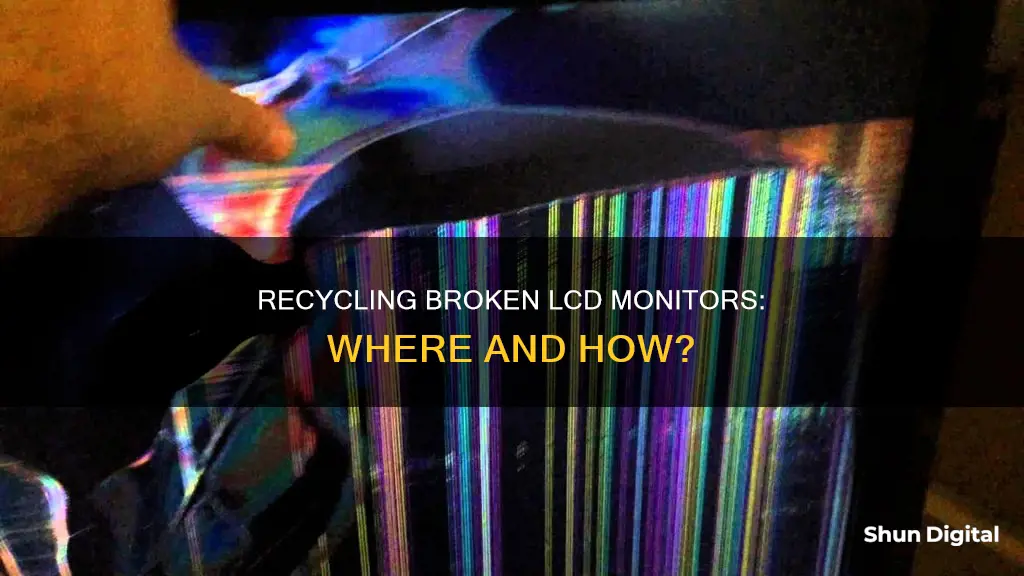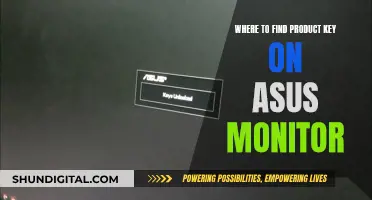
With technology constantly evolving, many people are upgrading their computer monitors. This has led to a huge amount of electronic waste, with almost 7 million tons of e-waste generated per year in America. As such, it is important to recycle your old LCD monitor. LCD monitors contain hazardous materials such as mercury, which can be harmful to the environment if not disposed of properly. Therefore, it is important to recycle your LCD monitor at a specialist facility.
Where to Recycle Broken LCD Monitors
| Characteristics | Values |
|---|---|
| Retailers | Staples, Best Buy, Goodwill |
| Manufacturers | Dell, LG, HP, Apple |
| Municipal Waste Center | CalRecycle in California |
| Online Services | GreenCitizen, ecoATM, eBay |
| Other | Local scrap metal recyclers, local schools or charities |
What You'll Learn

Retailers that recycle LCD monitors
LCD monitors contain toxic metals such as mercury, which can be harmful to the environment if not disposed of properly. Therefore, it is important to recycle them responsibly. Here are some retailers that offer LCD monitor recycling:
- Staples: Staples has been offering computer monitor recycling since 2007 and accepts both CRT and LCD screens, as well as other computer parts.
- Best Buy: Best Buy started recycling computer monitors in 2008 and accepts CRT and LCD screens. They charge a fee for recycling monitors, unless you live in California. Best Buy also offers a haul-away service for larger items.
- GreenCitizen: GreenCitizen is an environmental conservation company that provides electronics recycling services. They have a drop-off location in the San Francisco Bay Area and also offer a mail-in recycling program for those who live far away.
- Cash4LCD's: This company specializes in recycling broken glass LCD screens from cellphones and logic boards. They buy used LCDs regardless of the condition of the glass and cover shipping costs for orders of 50 or more LCDs.
- Manufacturers: Many computer monitor manufacturers now offer take-back recycling programs, either by partnering with retailers or through mail-in programs. For example, LG offers a drop-off or mail-in service, while Dell accepts any brand of products. Apple has a trade-in program where you can return old devices and receive money off a new purchase.
- Retail Store Recycling Programs: Many major electronics stores now offer recycling programs where you can drop off computers, laptops, TVs, and monitors, regardless of where you purchased them. For example, Walmart has introduced the ecoATM concept, which allows you to turn old electronics into cash.
HD vs LCD Monitors: Which Screen is Superior?
You may want to see also

Preparing your monitor for recycling
Before taking your monitor to a recycling centre, there are a few steps you should take to ensure the process is safe and smooth.
Firstly, if your monitor is cracked or broken, explore repair options. Check if your monitor is under warranty, as the manufacturer may be able to fix or replace it for you. If it's beyond repair, but the crack is minor, a screen protector might help extend the life of your monitor.
If you're getting rid of an old monitor or upgrading your system, consider reselling or trading it in. Working monitors often have good resale value, and even broken ones can fetch a good price from the right buyer. You can search online for local businesses that offer cash for tech, or explore trade-in programs offered by major computer manufacturers.
If your monitor is damaged beyond repair or resale, it's time to recycle it. Find a local monitor recycling company with a good reputation and transparent recycling processes. Remember, monitor recycling can be risky due to the potential for toxic exposure, so choose a company that complies with all federal and state codes.
When you're ready to hand over your monitor, unplug all wires and cables, and clean the monitor with a dry cloth. If the screen is cracked, use bubble wrap to pack it securely. Be sure to inform the recycling company about the crack so they can come prepared.
Transporting your monitor to the recycling centre also requires care. Place a towel or blanket in your car and put the monitor face down on top. This will protect it from breaking during the journey. Use a dolly or rolling chair to move the monitor to your car, especially if it's a heavy CRT monitor, to avoid the risk of dropping it.
Best Places to Buy AOC LCD Monitors
You may want to see also

Why you shouldn't throw away your monitor
There are several reasons why throwing away your monitor is a bad idea, from environmental and health concerns to legal issues. Here are some reasons why you should think twice before tossing your old monitor in the trash:
Environmental Impact
Electronic waste, or e-waste, is a significant contributor to the growing problem of hazardous waste. Monitors and other electronic devices contain various toxic metals and chemicals, such as lead, mercury, and cadmium, which can pose a serious threat to the environment if not disposed of properly. These substances can seep into the soil and water supply, causing irreversible damage to plant, animal, and human life. Even modern LCD monitors contain small fluorescent bulbs with mercury, which is extremely toxic. By throwing away your monitor, you risk releasing these harmful substances into the environment.
Health Hazards
The toxic materials found in monitors and other electronic waste can have severe health consequences for humans. Consistent exposure to these metals and chemicals can lead to health problems affecting the lungs, liver, kidneys, brain, and even bone structure. The contamination often occurs gradually over many years, and by the time symptoms appear, the damage may be permanent. Therefore, it is crucial to dispose of old monitors properly to protect public health.
Illegal Dumping
In many places, it is illegal to throw away electronic waste, including monitors, in the trash. As of 2017, half of the US states require the recycling of some forms of electronics, and 17 of those states have banned them from landfills. Additionally, throwing away electronics with personal information can lead to identity theft and privacy breaches. To comply with the law and protect your personal information, it is essential to recycle or donate your old monitor instead of throwing it away.
Reuse and Recycling Opportunities
Donating or recycling your old monitor is a more sustainable option that benefits both the environment and your community. Many charities and organisations gladly accept working monitors, helping those in need obtain functional technology. Additionally, computer manufacturers, such as Apple, Dell, Epson, Gateway, IBM, and Hewlett Packard, offer their own recycling programs, allowing you to ship or drop off your old monitor for responsible recycling. Furthermore, big-box stores like Staples, Best Buy, and Office Max often have electronics recycling programs, providing an easily accessible option for recycling your old monitor.
In conclusion, throwing away your monitor can have detrimental effects on the environment and human health, and it may even be illegal in your area. Instead, consider donating or recycling your old monitor to reduce the impact on the environment and give it a second life. By taking the time to dispose of your monitor responsibly, you can help create a greener and safer world for future generations.
Monitoring Memory Usage: A Guide for PFsense Users
You may want to see also

Recycling centres that accept LCD monitors
LCD monitors contain toxic metals such as mercury and lead, so it's important to keep them out of landfills and recycle them responsibly. Here are some recycling centres that accept LCD monitors:
- Retail stores: Many major electronics stores, including Staples and Best Buy, offer recycling programs where you can drop off old computer monitors and other electronic waste. Best Buy charges a fee for recycling monitors, unless you live in California.
- Manufacturers' recycling programs: Some manufacturers, such as LG, Dell, HP, and Apple, offer recycling programs where you can return old computer monitors and other electronic devices for proper recycling. Dell accepts products from other manufacturers, and Apple offers discounts when you trade in old Apple products.
- E-waste recycling centres: These specialised recycling centres have the necessary machinery and equipment to safely recycle electronic waste. GreenCitizen, with locations in the San Francisco Bay Area, is one example of an e-waste recycling centre.
- Municipal waste centres: Some municipalities have drop-off centres with electronics recycling programs. For example, California has a program called CalRecycle.
- Take-back programs: With the shift to LED monitors, some manufacturers and retailers have introduced take-back programs where you can return your old LCD monitors for organised recycling initiatives.
Before bringing your LCD monitor to a recycling centre, it's important to properly prepare it for transport and recycling. This includes unplugging all cables, wrapping the monitor in a towel or blanket, and placing it face down in your vehicle to avoid damage during transportation. Additionally, make sure to familiarise yourself with your local laws and guidelines regarding electronic waste and recycling.
Power Cycling Your ASUS Monitor: A Simple Guide
You may want to see also

Manufacturers' recycling programs
- LG: LG offers a simple process where you can find a drop-off site near you or mail in your monitor at your own expense. They accept all electronics they manufacture and partner with some of the largest recycling companies.
- Dell: Dell takes a unique approach by accepting any brand of product, not just Dell-branded items. They offer a drop-off and mail-in service, so you can choose the most convenient option for you.
- HP: HP provides a free recycling service for all HP and Compaq devices.
- Apple: Apple has a trade-in program where you can return old devices and receive money off your next purchase. They also offer discounts when you trade in an old Apple product for a new one.
- Staples and Best Buy: These nationwide retailers accept both LCD and CRT monitors. They have been recycling computer monitors since 2007 and 2008, respectively, and also accept other computer parts. Best Buy charges a fee for recycling monitors, unless you live in California.
Before dropping off or mailing in your old LCD monitor, be sure to unplug all wires and cables and wrap the monitor in a towel or blanket to protect it during transport. Also, remember to check the manufacturer's website for specific details about their recycling program, as processes may vary.
Monitoring Tomcat Memory Usage: A Comprehensive Guide
You may want to see also
Frequently asked questions
You can recycle your broken LCD monitor at a variety of places, including:
- Retailers such as Best Buy, Staples, and Goodwill.
- The manufacturer of the monitor.
- A local recycling center.
- A scrap metal recycler.
Yes, there are a few steps you should take to prepare your monitor for recycling:
- Unplug any cables, including power cords, from the monitor.
- Transport the monitor in a safe manner, such as by wrapping it in a towel and placing it face down in your car.
- Find a drop-off location near you that accepts computer monitors.
LCD monitors contain hazardous materials such as mercury, which can be harmful to the environment if not disposed of properly. Recycling helps to keep these toxic metals out of landfills and prevents them from leaching into the soil and water table.
Yes, if your monitor is still functional, you could consider donating it to a local school, charity, or someone in need. You could also try to get it repaired or sell it for parts.







